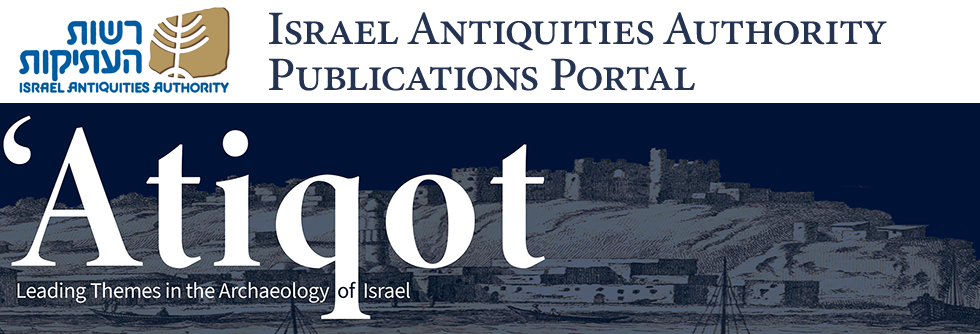[First posted 10/31/10, most recently updated 1 September 2025]

‘Atiqot is an open access, non-profit thematic journal dedicated to specific topics related to the archaeology of Israel. It is published by the Israel Antiquities Authority three times a year, online and in print. All content published in the journal is subject to double-blind peer-review and language editing. The printed volumes are available for purchase via the IAA website.
Current Volume: Volume 118 (2025) Ancient Industry, Production and Crafts
This volume is dedicated to crafts and industry in the Southern Levant. The topics are broad and varied, encompassing multiple periods spanning the Chalcolithic through medieval times, covering a range of geographical regions, from the northern Negev to Galilee and the Golan Heights. The varied research provides a glimpse into the archaeology of crafts and industry in Israel.Front matter
Editorial Board and Eli Cohen-SassonResearching Chalcolithic Ivories from the Southern Levant: Craft Items for Ritual, Prestige and Exchange
Harel Shochat, Liora Kolska Horwitz, Avishay Levi-Hevroni, Martin D. Pasternak, Pablo Betzer, Daniel Varga, Yael Abadi-Reiss, Olga Negnevitsky, Ilan Naor, and Ianir MilevskiThe Development of Tin Bronze in the Southern Levant during the Bronze Age
Ilana Peters, Yotam Asscher, and Naama Yahalom-MackSecondary Use of Textiles for Wick Production in Light of the Finds from the Intermediate Bronze Age Cemetery at Newe Efrayim
Naama Sukenik, Yonah Maor, Yaniv Agmon, Yossi Elisha, and Gilad Itach“Shihin FR” Oil Lamps: Technology from Scratch
Yehoshua (Yeshu) Dray and Ilana GonenA Major Pottery-Production Center at Yavne, Israel
Liat Nadav-Ziv and Jon SeligmanNahal Rimmonim: An Intermediate–Middle Bronze Age Village and Pottery Workshop in the Jezreel Valley
Karen Covello-Paran and Yotam TepperPetrographic Examination of the Intermediate and Middle Bronze Age Vessels from Nahal Rimmonim
Anastasia ShapiroThe Flint Assemblage from Nahal Rimmonim
Ariel VeredThe Faunal Assemblage from Nahal Rimmonim, an Intermediate and Middle Bronze Age Site in the Jezreel Valley
Zohar Turgeman-YaffeA Middle Bronze IIA Pottery Production Site on the Northern Bank of Naḥal Soreq, near Yavne-Yam
Lily Singer-Avitz, Yossi Levy, and Etan AyalonRemains of Two Iron Age IIB–C(?) Updraft Pottery Kilns at the Foot of Tel Gamma (Tell Jemma)
Davida Eisenberg-Degen, Ilana Peters, Svetlana Talis, Yael Abadi-Reiss, Emily Bischoff Bruintjes, and Yotam AsscherCrusader-Period Ceramics from the Knights’ Hotel Site, ‘Akko
Edna J. Stern and Nohar ShaharTobacco Pipes from ‘Akko, the Knights’ Hotel Site
Anastasia ShapiroPetrographic and Microscopic Examination of Crusader-Period Pottery from ‘Akko, the Knights’ Hotel Site
Anastasia ShapiroCrusader-Period Glass Finds from ‘Akko, the Knights’ Hotel Site
Yael Gorin-RosenStone Objects from ‘Akko, the Knights’ Hotel Site
Anastasia ShapiroFragments of a Crusader-Period Chancel Screen from ‘Akko, the Knights’ Hotel Site
Vardit R. Shotten-Hallel
See the fill List of Open Access Journals in Ancient Studies
No comments:
Post a Comment